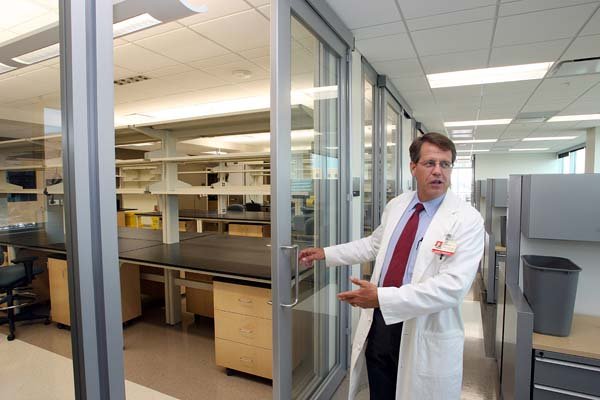LITTLE ROCK — Workers will rush this weekend to move furniture and supplies to the newly expanded Winthrop P. Rockefeller Cancer Institute for its first patients Monday.
The $130 million expansion tower adds 12 floors totaling 330,000 square feet to the existing 200,000-squarefoot facility, which is the only comprehensive cancer treatment and research center in the state.
The center draws about 120,000 visits a year, seeing cancer patients from every state and 40 countries.
The new space at the University of Arkansas for Medical Sciences facility was designed to promote comfort and quell anxieties associated with the life-threatening disease.
“The patient care environment is very important for patients, especially cancer patients,” said Dr. Daniel W. Rahn, chancellor of UAMS. “To be able to receive treatment in a facility that is uplifting really can improve outcomes.”
Researchers will also follow patients. The move puts a single flight of stairs between clinicians and researchers, who previously traveled among three buildings to see one another face to face.
“The two keys are patient centered and increased collaboration,” said Dr. Peter Emanuel, director of the Rockefeller Institute. “We thought a lot about how to make conversations happen.”
The institute has been housed in the neighboring 11-story Pat and Willard Walker Tower, which first opened in 1989 and was completed in 1994. It was renamed for the former lieutenant governor, who had leukemia, at a 2007 groundbreaking ceremony for the expansion.
A one-year renovation of the Walker tower will follow the move to the new space.
The project was financed through $37.5 million of general improvement funds from the state Legislature matched by private contributions, $35 million from increased tobacco taxes and $9.3 million from the Winthrop P. Rockefeller Foundation.
INCREASED COLLABORATION
The laboratory of Dr. Larry Suva, the Carl L. Nelson Chair of Orthopaedic Creativity at UAMS, will be the first to open in the new tower next week. His staff of eight will move from some of the oldest research space on the UAMS campus to a lab on the ninth floor, sharing space with other researchers.
“My whole academic career has been one where collaboration has been critical,” Suva said. “The future of research is not one person tucked away alone in their little cubbyhole. There’s very little lab space in the country like this.”
The building’s design team, from Little Rock-based Cromwell Architects and Houston-based FKP Architects, observed researchers at work and traveled to several cancer-research centers around the country before designing the space, Cromwell architect Hrand Duvalian said.
“A building means nothing if there isn’t a plan to work it,” he said.
White boards line the corridors of the research wings, where Duvalian hopes informal conversations will spark new partnerships. Open shelves and shared lab counters will encourage interaction in a similar manner, Emanuel said.
Administrators drew plans for the 12-story shell, intending to leave a few floors incomplete for the needs of future researchers.
A $10.5 million grant from the National Institutes of Health, provided through the American Recovery and Reinvestment Act, will help finish the rest of the ninth floor and all of the 11th floor.
Emanuel hopes the space will allow him to attract researchers, bringing their staffs and competitive grants with them.
“Researchers aren’t convinced by blueprints alone, especially in this economy,” he said.
PATIENT-CENTERED
Duvalian said architects referred to standards for hotel interiors, trying to free themselves from the clinical aesthetic that often intensifies anxiety associated with cancer. Many of those receiving treatment aren’t familiar with such large facilities.
Natural slate lines the walls of the elevator bank that spans all 12 floors, serving as a go-to point for disoriented patients.
“When they’re used to a doctor’s office in Dumas, they may not be familiar with this level of complexity,” Duvalian said. “If you can lay one thing to rest, you can concentrate on the other things you have to do in your life.”
In a similar vein, an expansive reception space near the front of the tower greets new patients. More experienced patients can use “frequent flier” kiosks, swiping a credit card or driver’s license on touchscreen computers to check in for appointments.
In chemotherapy infusion suites, broad horizontal frosted bands are narrowly spaced on glass partitions, providing privacy for patients while allowing natural light through. The bands grow narrow farther up the partitions, separating at a nurse’s eye level to allow staff to communicate throughout the space.
Fifteen years ago, aggressive anti-nausea medications required during chemotherapy treatments would exhaust patients, who would often sleep through the day as the drugs dripped into their veins through an intravenous tube, Emanuel said.
“They could have been in a dungeon, and it wouldn’t have mattered,” he said.
But advances in anti-nausea medications mean patients are now awake during treatment, making comfort, light and interaction more important.
A multidisciplinary lung cancer clinic will also allow patients with the state’s most common form of cancer to see radiologists, surgeons and specialists without traveling to multiple clinics. It’s a model the director hopes to spread in the future as the building is completed.
In a “dry run” of the space last week, workers adjusted a white marble sculpture in a first-floor garden while people in wheelchairs attempted to drop seedlike metal coins into its opening.
Patients will receive two coins engraved with the word “hope” after their final chemotherapy treatment or surgery - one to keep and one to toss into the sculpture.
Emanuel hopes to see the coins quickly pile up.
“We’re trading our dingy space for new space,” he said. “We’re ready to see patients using it.”
Arkansas, Pages 9 on 07/31/2010
